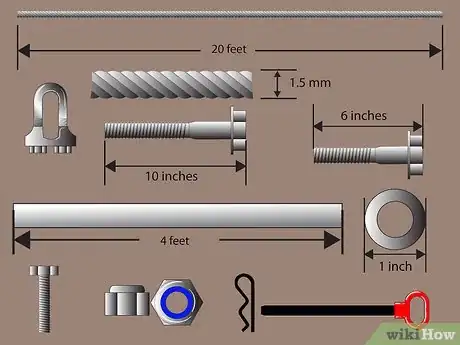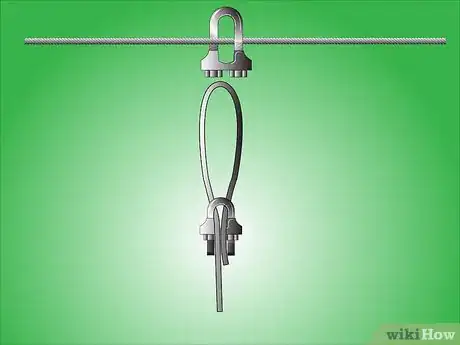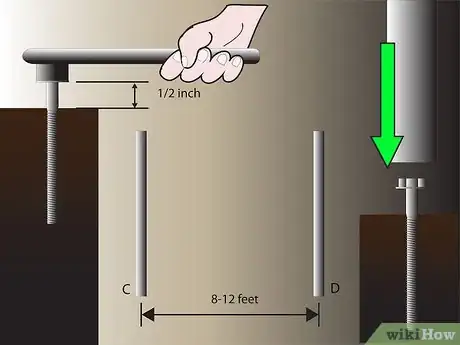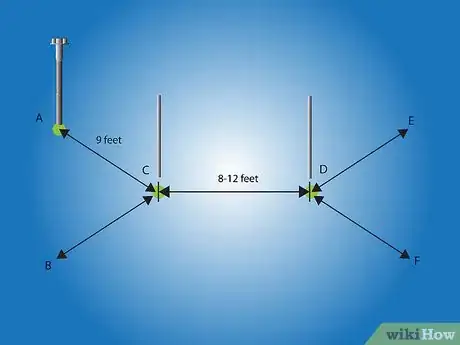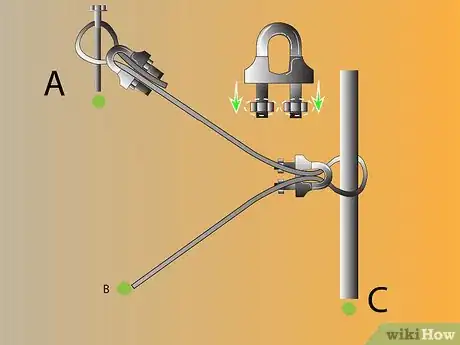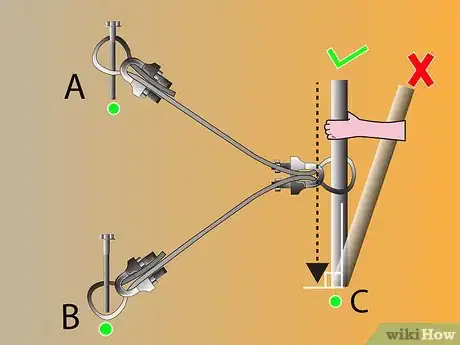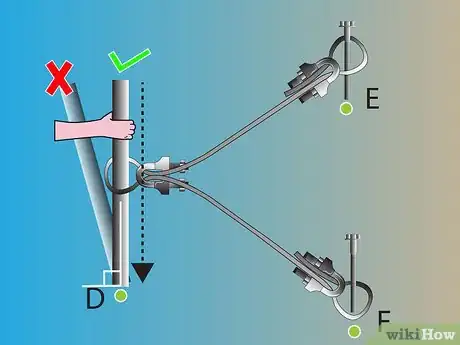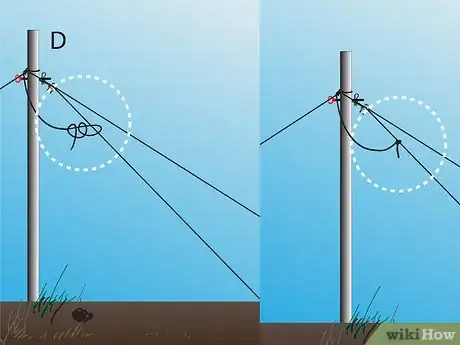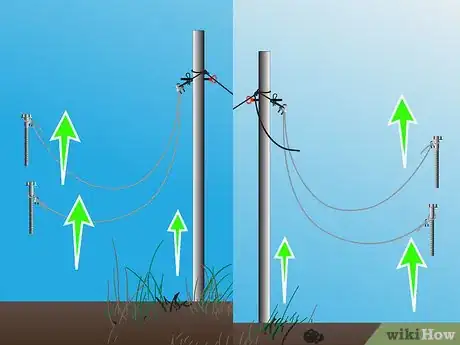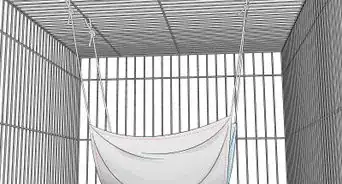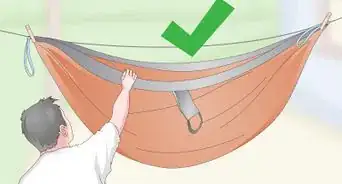wikiHow is a “wiki,” similar to Wikipedia, which means that many of our articles are co-written by multiple authors. To create this article, 15 people, some anonymous, worked to edit and improve it over time.
This article has been viewed 155,492 times.
Learn more...
A hammock, especially an ultralight hammock, makes life very sweet for backpackers. But in the desert, or on a beach, while you still get the "tent" benefits, you no longer enjoy the comfort of hanging suspended in the air, above the ground. In addition, you have snakes, spiders, and scorpions to contend with, and you get the worst of the dust. For another twenty or thirty dollars, and a few more pounds weight, you can hang your hammock just about anywhere using this approach, and you don't need to worry about critters, nor bring your sleeping bag and pad.
Steps
-
1Procure aircraft cable and specialty hardware. Have a hardware store cut you two pieces of an inch (1.5mm) aircraft cable, each at least twenty feet long. Buy at least six (6) 1/16 inch (1.5mm) cable clamps while you're there, along with four (4) ½ inch (1.27cm) by 10 inch (25cm) lag bolts and two shorter lag bolts not less than 6 inches (15cm) long. Two pieces of one inch (2.5cm) round or square aluminum tubing, at least 4 feet (1.2 meters) long, are necessary also. If you don't have an assortment of hardware at home, buy two ¼-20 x 2" (6.35mm x 5cm) bolts and Mylock nuts, or two ¼x2" (6.35mm x 5cm) hitch (or clevis) pins with hitch pin clips.
-
2Make a loop on each end of each cable using the cable clamps. Three clamps for each loop are recommended for safety, but for reasons explained below, this overkill should not be necessary.Advertisement
-
3Drill a ¼ inch (6.35mm) hole through one end of each tube, about 2 inches (5cm) from the end. Through each of these holes, insert a bolt with locknut, or a clevis pin with a hitch pin clip.
-
4Screw 6-inch (15cm) or longer lag bolts into the ground about 8 to 12 feet apart (points C and D in the drawing). Leave only about ½ inch (1.27cm) sticking out of the ground. The poles go over the heads of the bolts, and they keep the base of the poles from shifting position.
- It is quickest to use a ratcheting socket wrench for this operation.
-
5Screw in one of the 10-inch lag bolts at point A in the drawing. The distance, assuming 20-foot (6 meter) cables and 4-foot (1.2 meter) poles, would be about 9 feet (2.7 meters) from point C.
-
6Removing the nuts from one of the cable clamps, make a loop at about the midpoint of the first aircraft cable, just big enough to fit over the pole. Holding the pole upright, slide the loop so that the cable between points A and C is very tight. Screw the nuts back on tight.
-
7Screw in a 10-inch (25cm) lag bolt at point B, securing the first pole. Have a friend hold the pole plumb and upright if possible while locating point B, otherwise use stones or some other means to make sure the pole is (close to) perfectly upright when the anchoring cable is tight.
-
8Repeat the previous three steps for points D, E, and F, using the second piece of aircraft cable.
-
9Mount your hammock, using two half hitches at point C, and a taut-line hitch at point D. Slide the hitch until the hammock rope is very tight.
-
10Sit in the middle of the hammock, and make sure your bottom doesn't hit the ground. If it does, adjust the taut-line hitch at point D. Practically speaking, there will be some stretch in the rope and fabric which will necessitate performing this step three or more times until everything is tight. If there is no more "take-up" room on the side with the taut-line hitch, loosen it; undo the two half-hitches at point C; and re-tie them closer to the hammock. Then you will have more room for adjustments. Ideally you will be only an inch or two above the ground when the setup is complete, meaning only a slight impact if something breaks or a lag bolt pops out of the ground.
-
11With the working end of the taut-line hitch, tie another two (or more) half hitches around the cable, in case the wind lifts the hammock off the poles while you're not in it. Otherwise you'll be chasing it across the desert, then finally extracting it from a cactus or mesquite bush.
-
12Enjoy sleeping in your hammock as long as you stay in this location.
- Note: There is no need to remove the cable clamps when you break camp. The bolts or clevis pins may also be left in the poles; so the only thing necessary to do is remove the lag bolts and pack everything up.
Warnings
- Some hard-core ultralight backpackers will want to try using their telescoping hiking poles, which they're carrying anyway, to eliminate the long aluminum poles. They will most likely break. A better alternative would be to make the aluminum poles double as your hiking poles, or as part of your backpack frame.⧼thumbs_response⧽
Things You'll Need
-
During initial setup at home
- Drill with ¼" (6.35mm) titanium or cobalt drill bit
- Small adjustable wrench, or socket to fit aircraft cable clamp nuts
-
During setup and at campsite
- Two (2) 1" x 48" (2.5cm x 18.8cm) pieces of round aluminum tubing
- Four (4) ½" x 10" (1.27cm x 25cm) lag bolts
- Two (2) ½" x 6" (1.27cm x 15cm) lag bolts
- Socket wrench to fit lag bolts
- Two (2) 1/16" x 20' (1.5mm x 6m)pieces of aircraft cable
- Six (6) 1/16" (1.5mm) aircraft cable clamps
- Two (2) ¼" x 2" (6.35mm x 5cm) bolts with locknuts, or clevis pins with hitch pin clips
- Hammock
References
- This research was made possible, in part, by a land grant from the City of the Sun Foundation (http://directory.ic.org/records/?action=view&page=view&record_id=20103), though the specifics of the research were not coordinated nor endorsed by COSF.
